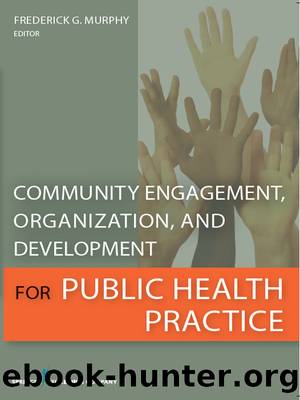Community Engagement, Organization, and Development for Public Health Practice by Murphy Frederick;Frederick Murphy Msphyg Mpia;

Author:Murphy, Frederick;Frederick Murphy Msphyg, Mpia;
Language: eng
Format: epub
Publisher: Springer Publishing Company, Incorporated
CHWs AS SOCIAL CAPITAL: A THEORETICAL FRAMEWORK OF CAPACITY BUILDING
We view trained CHWs as a critical component of social capital. Social capital, in turn, is a key component of community capacity building. Through the use of CHWs for capacity building, the concepts of several theories such as the Health Belief Model (HBM), Self-Determination Theory (SDT), Transtheoretical Model (TTM), and self-efficacy are all taking place at different stages when community members interact with CHWs for extended periods of time. This interaction forges relationships and bonds of trust that lead to social support, social networks, and continuous capacity building within the community and, subsequently, increased social capital. The increased social capital within a community leads to improved health status of individuals and healthier communities.
Depending on the academic discipline, the definition of social capital varies. Social capital is defined as ânot a single entity,â but a variety of different entities having two characteristics in common: (1) They all consist of some aspect of social structure, and (2) they facilitate certain actions of individuals who are within the structure (Coleman, 1990). Communities who are fortunate enough to have CHWs possess both characteristics. The community is the social structure and the CHW facilitates specific actions of the community members through social support (whether it be informational, instrumental, emotional, or appraisal), education, and providing resources to clients/patients within the community.
In the perspective of public health, both social cohesion and social networks are prominent features of social capital. The school of social cohesion posits that social capital is a group attribute and not an individual one. CHWs, although they work with individuals to educate, empower, and facilitate change in behavior, are actually creating social ties within the community (Kawachi et al., 2008). The information that is shared with individuals is often shared by word-of-mouth to family members, friends, church members, and other community members. Although the information is shared on the individual level, the community as a whole has the opportunity to benefit from information sharing. Through the education process, the CHW is increasing the knowledge, abilities, and skills of the community members to manage and control their health. The CHW is shaping the health beliefs of the participant, empowering and motivating the individual to take control of his or her health, and encouraging behavior change to promote a healthy lifestyle. Through this process, the CHW is the âgroup attributeâ that is building capacity on the community level.
Social networks are another aspect of the social capital theory. Social networks are centered on resources within the community. These resources include social support systems, social service agencies, faith-based organizations, food banks, and social credentials of individuals within the community (i.e., pastors, doctors, lawyers, teachers, business owners, etc.)âall are embedded within an individualâs social network (Lin, 1999). Social networks are often measured on both the individual and group level. The CHW develops both individual social networks and group networks. At the basic level, the individual bonds that the CHW develops with each individual are networks for that involved individual. On
Download
This site does not store any files on its server. We only index and link to content provided by other sites. Please contact the content providers to delete copyright contents if any and email us, we'll remove relevant links or contents immediately.
The Rosetta Stone of the Human Mind by Vincenzo R. Sanguineti(179)
Cardiology in a Heartbeat, second edition by Vaswani Amar;Khaw Hwan Juet;El-Medany Ahmed;Dougherty Scott;(174)
TSRA Operative Dictations in Cardiothoracic Surgery by unknow(157)
The Trauma Chronicles by Westaby Stephen(146)
If Joan of Arc Had Cancer : Finding Courage, Faith, and Healing from History's Most Inspirational Woman Warrior by Janet Lynn Roseman(144)
How Selegiline ((-)-Deprenyl) Slows Brain Aging by Joseph Knoll(139)
Lymphedema (Lymph Obstruction), a Simple Guide to the Condition, Diagnosis, Treatment and Related Conditions by Kenneth Kee(136)
The Heart Health Bible by John M. Kennedy(135)
Clinical Nephrology - 2020 by Weber MD C. G(133)
Dear Millie: Diary of a seven year old with cancer by Marco Previero(133)
Restful Insomnia by Sondra Kornblatt(124)
Fast Facts: Skin Cancer by unknow(123)
Rethinking Evidence in the Time of Pandemics: Scientific vs Narrative Rationality and Medical Knowledge Practices by Eivind Engebretsen Mona Baker(122)
Home and Dry by Birgit Bulla(120)
Community Engagement, Organization, and Development for Public Health Practice by Murphy Frederick;Frederick Murphy Msphyg Mpia;(118)
What Your Doctor May Not Tell You About Cholesterol by Stephen R. Devries & Winifred Conkling(116)
Fibromyalgia--Your Treatment Guide by Christine Craggs-Hinton(116)
The Plague of 1665 by Emma Laybourn(113)
Medical Materialities by Aaron Parkhurst Timothy Carroll(111)
